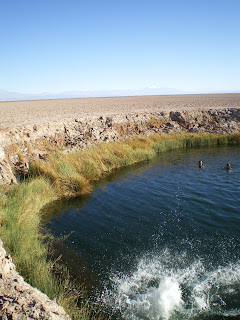The party helped us to get some sleep on the 24 hour bus journey to San Pedro de Atacama the next day. We jhad been dreading this trip, but actually chilean busus are erxcellent and very comfortable. We woke up in the desert somewhere around Antofagasta, and still had a long way to go.
San Pedro is an oasis in the middle of the driest place on earth. There are vast numbers of tourists here, but most are Chilean. We took a trip out into the Salt Water Lagoons and Ojos de Salar (big holes in the floor of valley, into the salt lake below). I plucked up the courage to throw myself into an Ojo when I had seen the depth tested by a few Brazilians. Our new digital camera was not fast enough to catch me in flight, but did catch the large displacement of water, admired by witnesses of all nationalities present.
In the evening the trip crossed the dry Salt Lake (Sala de Atacama), and again we tried to follow the instrcutions of exactly where to walk to avoid falling through the crust. It was worth following some weighty people across the Sala just to be sure.
The mountains around San Pedro are also spectacular and some observatories are based there, as the sky is rarely troubled by clouds. Today we plan to go into the Valle de la Muerte, and hopefully come out again. In the main square is this Spanish mission, built in adobe like most other buildings here, and dating from the 16th Century. Presumably the Catholics came here to convert the local lizards, who probably weren't expecting the Spanish Inquistion.


































